Complete Business Solutions Australia: Communication Protocols Project
VerifiedAdded on 2023/06/10
|59
|10387
|358
Project
AI Summary
This assessment task requires the student, acting as the Human Resources Manager for Complete Business Solutions Australia (CBSA), to update the company's communication protocols. The task involves analyzing communication needs, particularly addressing the transition to remote work, virtual team meetings, and the specific requirements of a new client, Deafness Foundation, who work with Deaf and Hard of Hearing individuals. The student must review existing protocols, update them to incorporate best practices for virtual meetings (including client meetings), and research the client's needs to ensure effective communication. This includes detailing how to facilitate professional virtual meetings, incorporating closed captions and Auslan interpreters where necessary, and incorporating the provided documents and templates. The final deliverable is an updated Communication Policy Procedures document reflecting these changes.
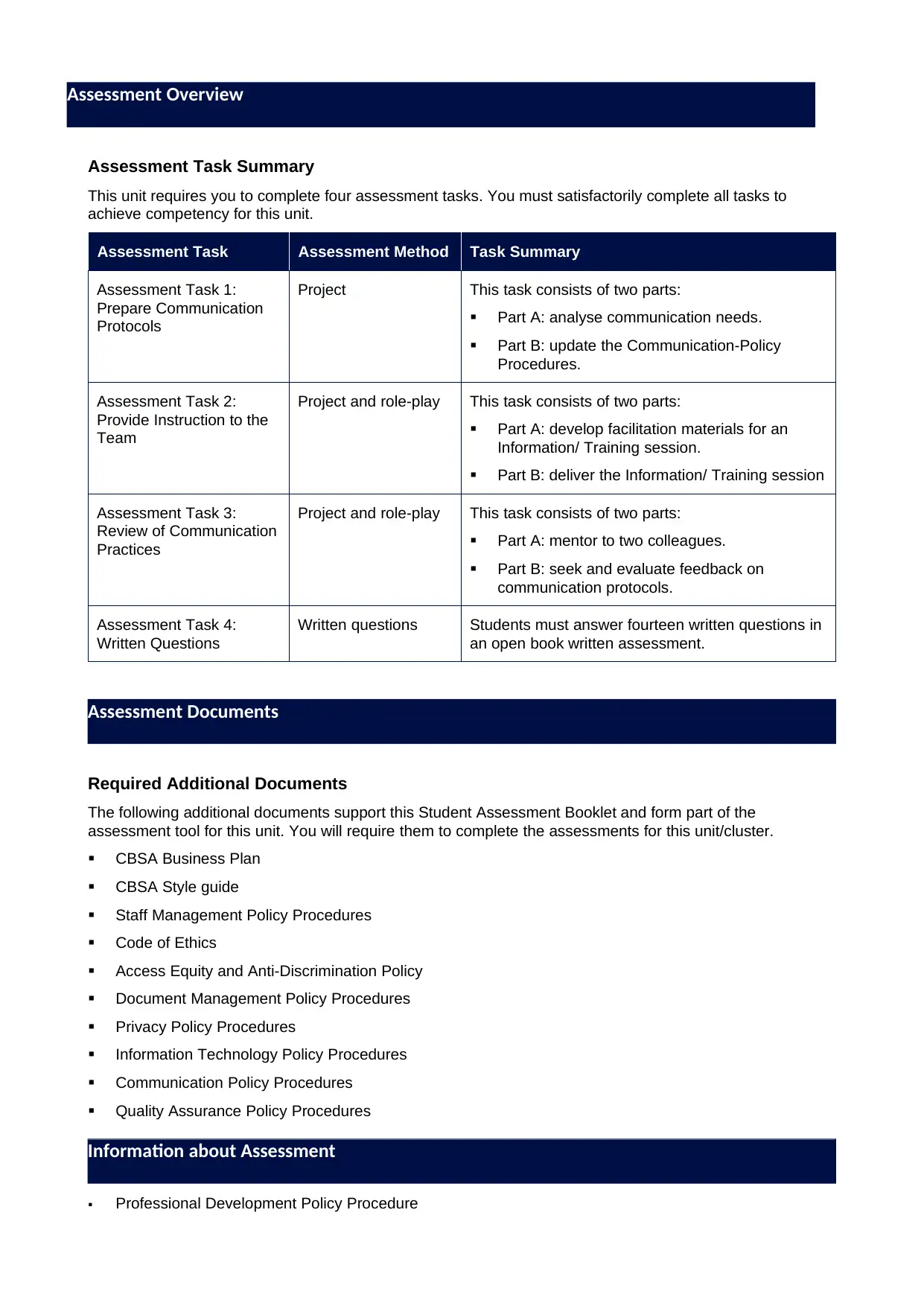
Assessment Task Summary
This unit requires you to complete four assessment tasks. You must satisfactorily complete all tasks to
achieve competency for this unit.
Assessment Task Assessment Method Task Summary
Assessment Task 1:
Prepare Communication
Protocols
Project This task consists of two parts:
Part A: analyse communication needs.
Part B: update the Communication-Policy
Procedures.
Assessment Task 2:
Provide Instruction to the
Team
Project and role-play This task consists of two parts:
Part A: develop facilitation materials for an
Information/ Training session.
Part B: deliver the Information/ Training session
Assessment Task 3:
Review of Communication
Practices
Project and role-play This task consists of two parts:
Part A: mentor to two colleagues.
Part B: seek and evaluate feedback on
communication protocols.
Assessment Task 4:
Written Questions
Written questions Students must answer fourteen written questions in
an open book written assessment.
Required Additional Documents
The following additional documents support this Student Assessment Booklet and form part of the
assessment tool for this unit. You will require them to complete the assessments for this unit/cluster.
CBSA Business Plan
CBSA Style guide
Staff Management Policy Procedures
Code of Ethics
Access Equity and Anti-Discrimination Policy
Document Management Policy Procedures
Privacy Policy Procedures
Information Technology Policy Procedures
Communication Policy Procedures
Quality Assurance Policy Procedures
Professional Development Policy Procedure
Assessment Overview
Assessment Documents
Information about Assessment
This unit requires you to complete four assessment tasks. You must satisfactorily complete all tasks to
achieve competency for this unit.
Assessment Task Assessment Method Task Summary
Assessment Task 1:
Prepare Communication
Protocols
Project This task consists of two parts:
Part A: analyse communication needs.
Part B: update the Communication-Policy
Procedures.
Assessment Task 2:
Provide Instruction to the
Team
Project and role-play This task consists of two parts:
Part A: develop facilitation materials for an
Information/ Training session.
Part B: deliver the Information/ Training session
Assessment Task 3:
Review of Communication
Practices
Project and role-play This task consists of two parts:
Part A: mentor to two colleagues.
Part B: seek and evaluate feedback on
communication protocols.
Assessment Task 4:
Written Questions
Written questions Students must answer fourteen written questions in
an open book written assessment.
Required Additional Documents
The following additional documents support this Student Assessment Booklet and form part of the
assessment tool for this unit. You will require them to complete the assessments for this unit/cluster.
CBSA Business Plan
CBSA Style guide
Staff Management Policy Procedures
Code of Ethics
Access Equity and Anti-Discrimination Policy
Document Management Policy Procedures
Privacy Policy Procedures
Information Technology Policy Procedures
Communication Policy Procedures
Quality Assurance Policy Procedures
Professional Development Policy Procedure
Assessment Overview
Assessment Documents
Information about Assessment
Paraphrase This Document
Need a fresh take? Get an instant paraphrase of this document with our AI Paraphraser
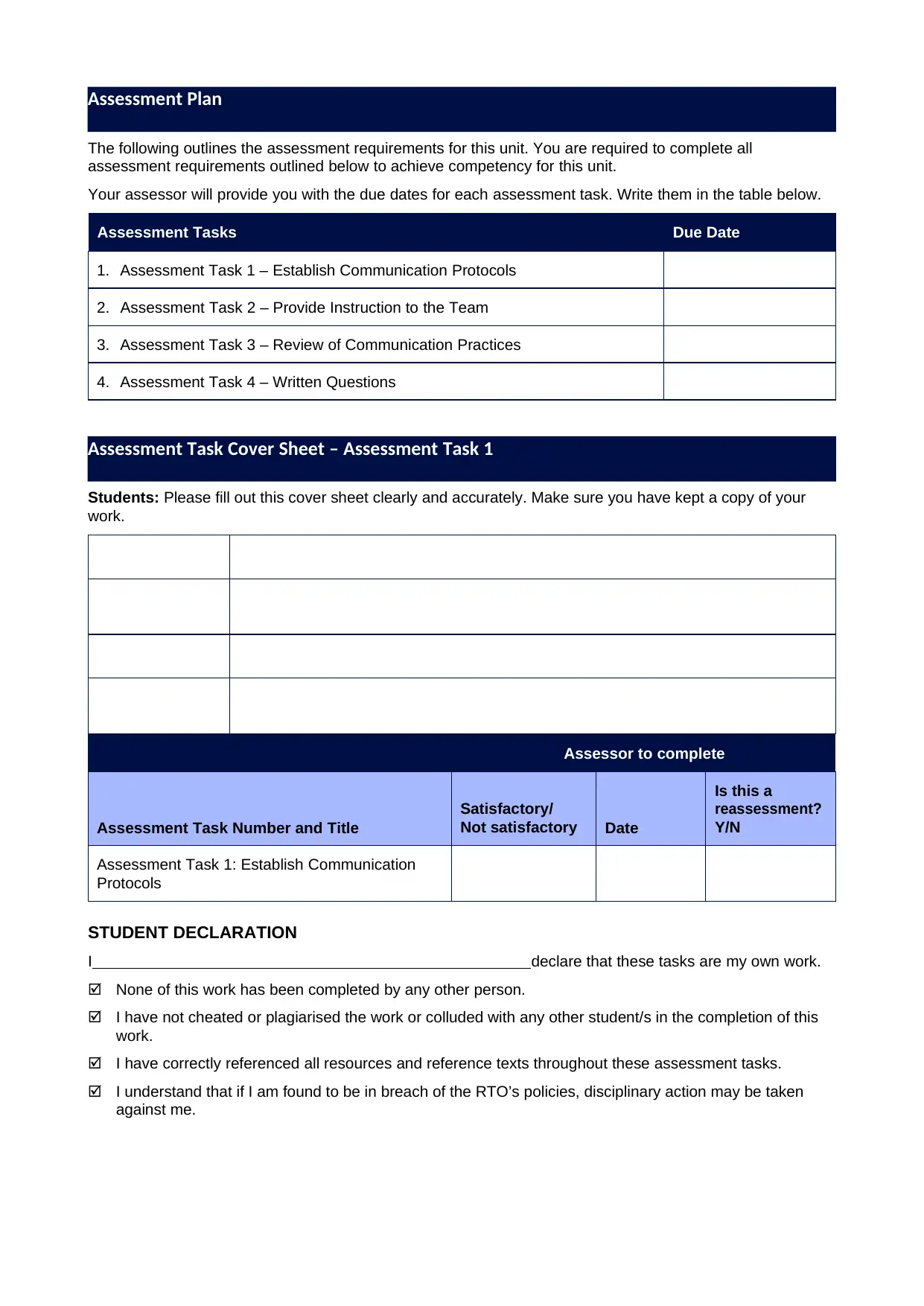
The following outlines the assessment requirements for this unit. You are required to complete all
assessment requirements outlined below to achieve competency for this unit.
Your assessor will provide you with the due dates for each assessment task. Write them in the table below.
Assessment Tasks Due Date
1. Assessment Task 1 – Establish Communication Protocols
2. Assessment Task 2 – Provide Instruction to the Team
3. Assessment Task 3 – Review of Communication Practices
4. Assessment Task 4 – Written Questions
Students: Please fill out this cover sheet clearly and accurately. Make sure you have kept a copy of your
work.
Assessor to complete
Assessment Task Number and Title
Satisfactory/
Not satisfactory Date
Is this a
reassessment?
Y/N
Assessment Task 1: Establish Communication
Protocols
STUDENT DECLARATION
I declare that these tasks are my own work.
None of this work has been completed by any other person.
I have not cheated or plagiarised the work or colluded with any other student/s in the completion of this
work.
I have correctly referenced all resources and reference texts throughout these assessment tasks.
I understand that if I am found to be in breach of the RTO’s policies, disciplinary action may be taken
against me.
Assessment Plan
Assessment Task Cover Sheet – Assessment Task 1
assessment requirements outlined below to achieve competency for this unit.
Your assessor will provide you with the due dates for each assessment task. Write them in the table below.
Assessment Tasks Due Date
1. Assessment Task 1 – Establish Communication Protocols
2. Assessment Task 2 – Provide Instruction to the Team
3. Assessment Task 3 – Review of Communication Practices
4. Assessment Task 4 – Written Questions
Students: Please fill out this cover sheet clearly and accurately. Make sure you have kept a copy of your
work.
Assessor to complete
Assessment Task Number and Title
Satisfactory/
Not satisfactory Date
Is this a
reassessment?
Y/N
Assessment Task 1: Establish Communication
Protocols
STUDENT DECLARATION
I declare that these tasks are my own work.
None of this work has been completed by any other person.
I have not cheated or plagiarised the work or colluded with any other student/s in the completion of this
work.
I have correctly referenced all resources and reference texts throughout these assessment tasks.
I understand that if I am found to be in breach of the RTO’s policies, disciplinary action may be taken
against me.
Assessment Plan
Assessment Task Cover Sheet – Assessment Task 1
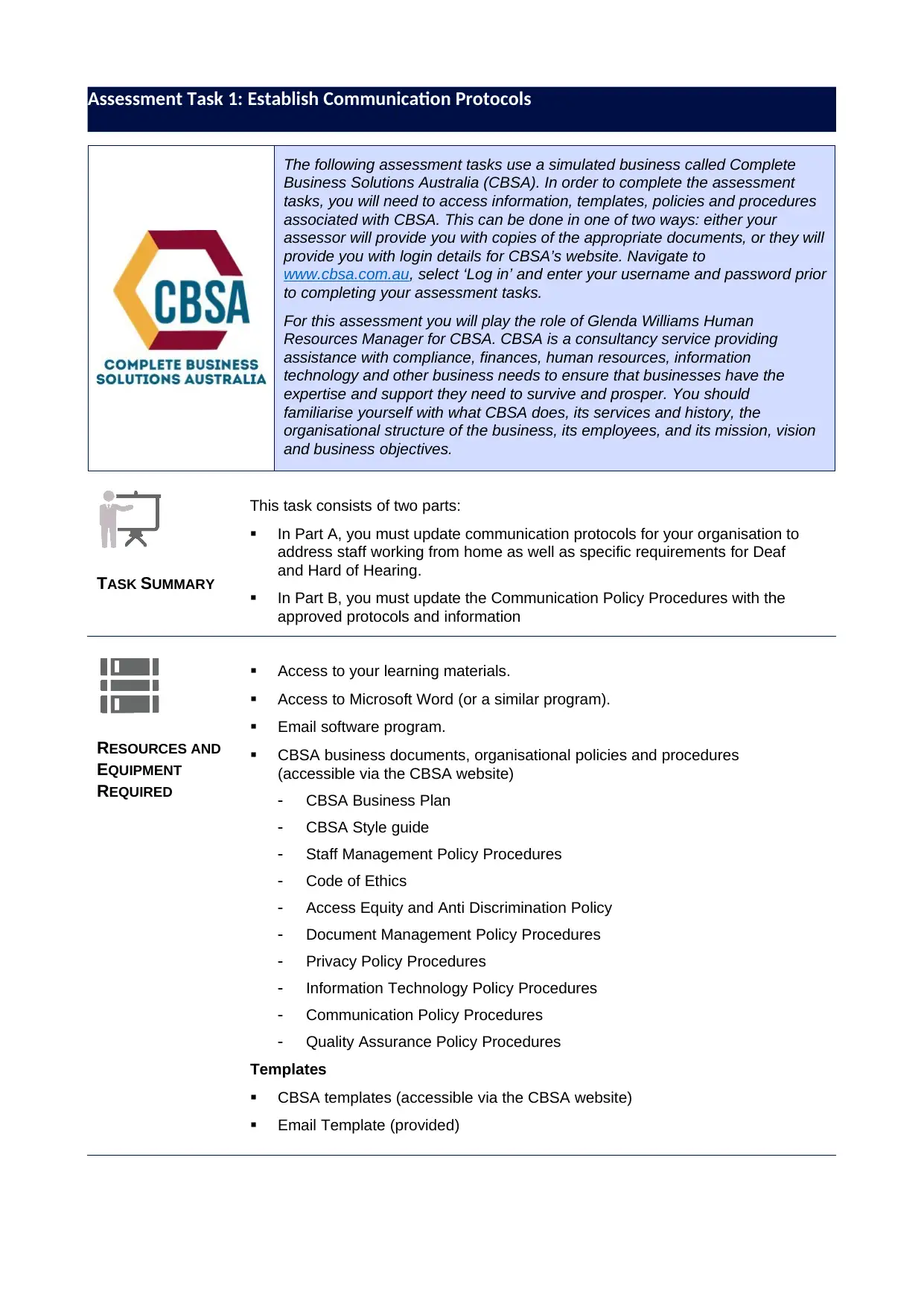
The following assessment tasks use a simulated business called Complete
Business Solutions Australia (CBSA). In order to complete the assessment
tasks, you will need to access information, templates, policies and procedures
associated with CBSA. This can be done in one of two ways: either your
assessor will provide you with copies of the appropriate documents, or they will
provide you with login details for CBSA’s website. Navigate to
www.cbsa.com.au, select ‘Log in’ and enter your username and password prior
to completing your assessment tasks.
For this assessment you will play the role of Glenda Williams Human
Resources Manager for CBSA. CBSA is a consultancy service providing
assistance with compliance, finances, human resources, information
technology and other business needs to ensure that businesses have the
expertise and support they need to survive and prosper. You should
familiarise yourself with what CBSA does, its services and history, the
organisational structure of the business, its employees, and its mission, vision
and business objectives.
TASK SUMMARY
This task consists of two parts:
In Part A, you must update communication protocols for your organisation to
address staff working from home as well as specific requirements for Deaf
and Hard of Hearing.
In Part B, you must update the Communication Policy Procedures with the
approved protocols and information
RESOURCES AND
EQUIPMENT
REQUIRED
Access to your learning materials.
Access to Microsoft Word (or a similar program).
Email software program.
CBSA business documents, organisational policies and procedures
(accessible via the CBSA website)
CBSA Business Plan
CBSA Style guide
Staff Management Policy Procedures
Code of Ethics
Access Equity and Anti Discrimination Policy
Document Management Policy Procedures
Privacy Policy Procedures
Information Technology Policy Procedures
Communication Policy Procedures
Quality Assurance Policy Procedures
Templates
CBSA templates (accessible via the CBSA website)
Email Template (provided)
Assessment Task 1: Establish Communication Protocols
Business Solutions Australia (CBSA). In order to complete the assessment
tasks, you will need to access information, templates, policies and procedures
associated with CBSA. This can be done in one of two ways: either your
assessor will provide you with copies of the appropriate documents, or they will
provide you with login details for CBSA’s website. Navigate to
www.cbsa.com.au, select ‘Log in’ and enter your username and password prior
to completing your assessment tasks.
For this assessment you will play the role of Glenda Williams Human
Resources Manager for CBSA. CBSA is a consultancy service providing
assistance with compliance, finances, human resources, information
technology and other business needs to ensure that businesses have the
expertise and support they need to survive and prosper. You should
familiarise yourself with what CBSA does, its services and history, the
organisational structure of the business, its employees, and its mission, vision
and business objectives.
TASK SUMMARY
This task consists of two parts:
In Part A, you must update communication protocols for your organisation to
address staff working from home as well as specific requirements for Deaf
and Hard of Hearing.
In Part B, you must update the Communication Policy Procedures with the
approved protocols and information
RESOURCES AND
EQUIPMENT
REQUIRED
Access to your learning materials.
Access to Microsoft Word (or a similar program).
Email software program.
CBSA business documents, organisational policies and procedures
(accessible via the CBSA website)
CBSA Business Plan
CBSA Style guide
Staff Management Policy Procedures
Code of Ethics
Access Equity and Anti Discrimination Policy
Document Management Policy Procedures
Privacy Policy Procedures
Information Technology Policy Procedures
Communication Policy Procedures
Quality Assurance Policy Procedures
Templates
CBSA templates (accessible via the CBSA website)
Email Template (provided)
Assessment Task 1: Establish Communication Protocols
⊘ This is a preview!⊘
Do you want full access?
Subscribe today to unlock all pages.

Trusted by 1+ million students worldwide
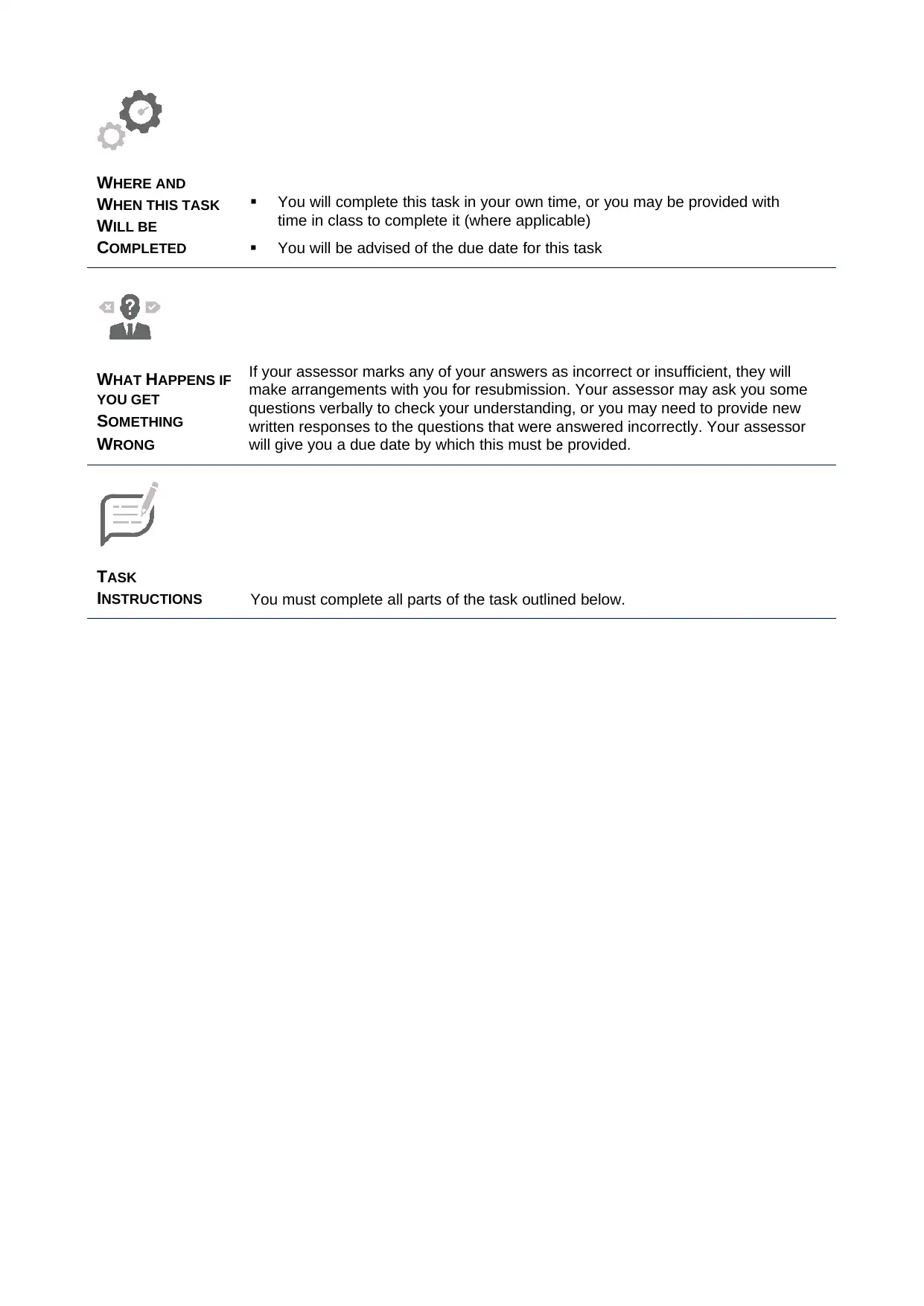
WHERE AND
WHEN THIS TASK
WILL BE
COMPLETED
You will complete this task in your own time, or you may be provided with
time in class to complete it (where applicable)
You will be advised of the due date for this task
WHAT HAPPENS IF
YOU GET
SOMETHING
WRONG
If your assessor marks any of your answers as incorrect or insufficient, they will
make arrangements with you for resubmission. Your assessor may ask you some
questions verbally to check your understanding, or you may need to provide new
written responses to the questions that were answered incorrectly. Your assessor
will give you a due date by which this must be provided.
TASK
INSTRUCTIONS You must complete all parts of the task outlined below.
WHEN THIS TASK
WILL BE
COMPLETED
You will complete this task in your own time, or you may be provided with
time in class to complete it (where applicable)
You will be advised of the due date for this task
WHAT HAPPENS IF
YOU GET
SOMETHING
WRONG
If your assessor marks any of your answers as incorrect or insufficient, they will
make arrangements with you for resubmission. Your assessor may ask you some
questions verbally to check your understanding, or you may need to provide new
written responses to the questions that were answered incorrectly. Your assessor
will give you a due date by which this must be provided.
TASK
INSTRUCTIONS You must complete all parts of the task outlined below.
Paraphrase This Document
Need a fresh take? Get an instant paraphrase of this document with our AI Paraphraser
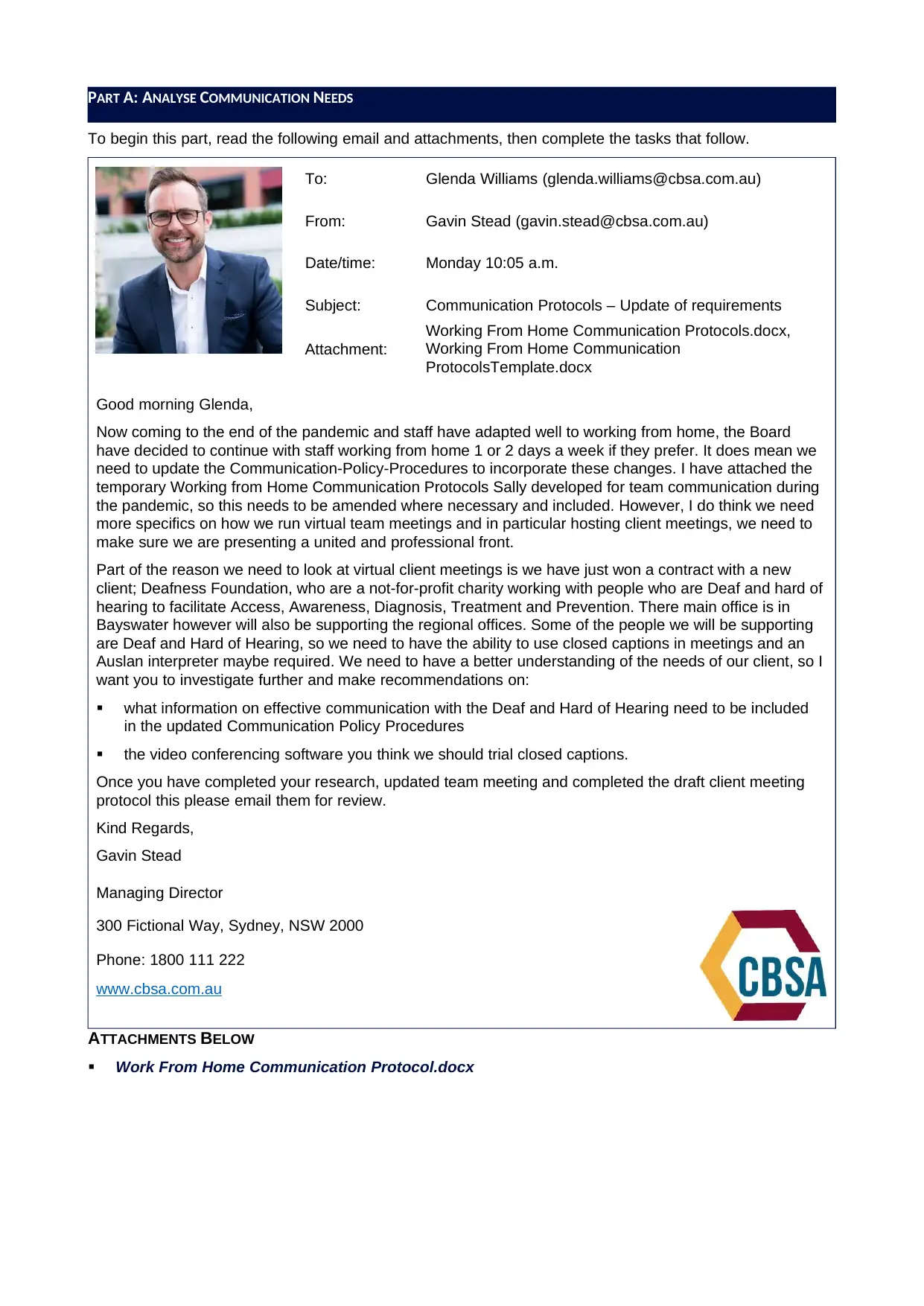
To begin this part, read the following email and attachments, then complete the tasks that follow.
To: Glenda Williams (glenda.williams@cbsa.com.au)
From: Gavin Stead (gavin.stead@cbsa.com.au)
Date/time: Monday 10:05 a.m.
Subject: Communication Protocols – Update of requirements
Attachment:
Working From Home Communication Protocols.docx,
Working From Home Communication
ProtocolsTemplate.docx
Good morning Glenda,
Now coming to the end of the pandemic and staff have adapted well to working from home, the Board
have decided to continue with staff working from home 1 or 2 days a week if they prefer. It does mean we
need to update the Communication-Policy-Procedures to incorporate these changes. I have attached the
temporary Working from Home Communication Protocols Sally developed for team communication during
the pandemic, so this needs to be amended where necessary and included. However, I do think we need
more specifics on how we run virtual team meetings and in particular hosting client meetings, we need to
make sure we are presenting a united and professional front.
Part of the reason we need to look at virtual client meetings is we have just won a contract with a new
client; Deafness Foundation, who are a not-for-profit charity working with people who are Deaf and hard of
hearing to facilitate Access, Awareness, Diagnosis, Treatment and Prevention. There main office is in
Bayswater however will also be supporting the regional offices. Some of the people we will be supporting
are Deaf and Hard of Hearing, so we need to have the ability to use closed captions in meetings and an
Auslan interpreter maybe required. We need to have a better understanding of the needs of our client, so I
want you to investigate further and make recommendations on:
what information on effective communication with the Deaf and Hard of Hearing need to be included
in the updated Communication Policy Procedures
the video conferencing software you think we should trial closed captions.
Once you have completed your research, updated team meeting and completed the draft client meeting
protocol this please email them for review.
Kind Regards,
Gavin Stead
Managing Director
300 Fictional Way, Sydney, NSW 2000
Phone: 1800 111 222
www.cbsa.com.au
ATTACHMENTS BELOW
Work From Home Communication Protocol.docx
PART A: ANALYSE COMMUNICATION NEEDS
To: Glenda Williams (glenda.williams@cbsa.com.au)
From: Gavin Stead (gavin.stead@cbsa.com.au)
Date/time: Monday 10:05 a.m.
Subject: Communication Protocols – Update of requirements
Attachment:
Working From Home Communication Protocols.docx,
Working From Home Communication
ProtocolsTemplate.docx
Good morning Glenda,
Now coming to the end of the pandemic and staff have adapted well to working from home, the Board
have decided to continue with staff working from home 1 or 2 days a week if they prefer. It does mean we
need to update the Communication-Policy-Procedures to incorporate these changes. I have attached the
temporary Working from Home Communication Protocols Sally developed for team communication during
the pandemic, so this needs to be amended where necessary and included. However, I do think we need
more specifics on how we run virtual team meetings and in particular hosting client meetings, we need to
make sure we are presenting a united and professional front.
Part of the reason we need to look at virtual client meetings is we have just won a contract with a new
client; Deafness Foundation, who are a not-for-profit charity working with people who are Deaf and hard of
hearing to facilitate Access, Awareness, Diagnosis, Treatment and Prevention. There main office is in
Bayswater however will also be supporting the regional offices. Some of the people we will be supporting
are Deaf and Hard of Hearing, so we need to have the ability to use closed captions in meetings and an
Auslan interpreter maybe required. We need to have a better understanding of the needs of our client, so I
want you to investigate further and make recommendations on:
what information on effective communication with the Deaf and Hard of Hearing need to be included
in the updated Communication Policy Procedures
the video conferencing software you think we should trial closed captions.
Once you have completed your research, updated team meeting and completed the draft client meeting
protocol this please email them for review.
Kind Regards,
Gavin Stead
Managing Director
300 Fictional Way, Sydney, NSW 2000
Phone: 1800 111 222
www.cbsa.com.au
ATTACHMENTS BELOW
Work From Home Communication Protocol.docx
PART A: ANALYSE COMMUNICATION NEEDS
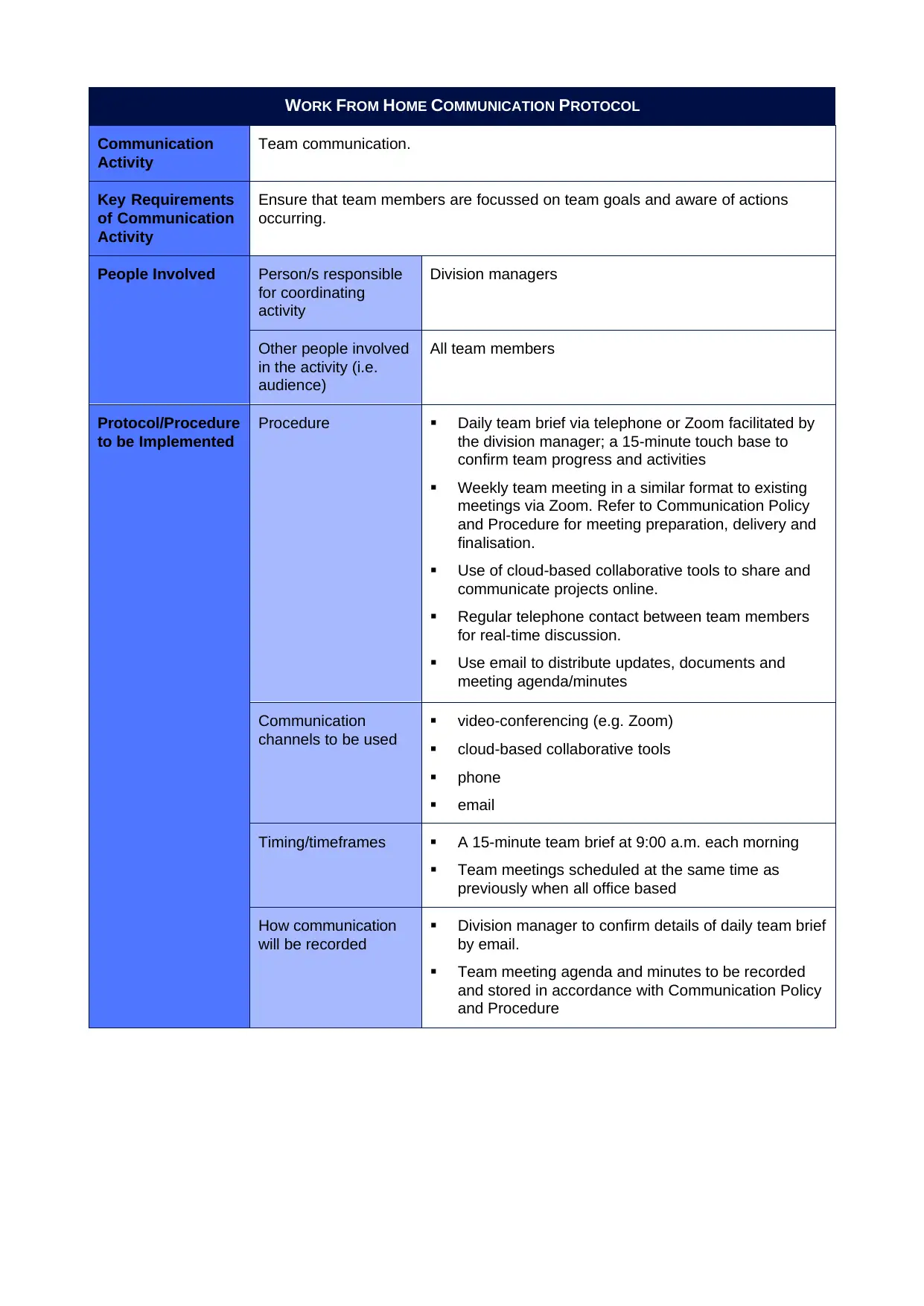
WORK FROM HOME COMMUNICATION PROTOCOL
Communication
Activity
Team communication.
Key Requirements
of Communication
Activity
Ensure that team members are focussed on team goals and aware of actions
occurring.
People Involved Person/s responsible
for coordinating
activity
Division managers
Other people involved
in the activity (i.e.
audience)
All team members
Protocol/Procedure
to be Implemented
Procedure Daily team brief via telephone or Zoom facilitated by
the division manager; a 15-minute touch base to
confirm team progress and activities
Weekly team meeting in a similar format to existing
meetings via Zoom. Refer to Communication Policy
and Procedure for meeting preparation, delivery and
finalisation.
Use of cloud-based collaborative tools to share and
communicate projects online.
Regular telephone contact between team members
for real-time discussion.
Use email to distribute updates, documents and
meeting agenda/minutes
Communication
channels to be used
video-conferencing (e.g. Zoom)
cloud-based collaborative tools
phone
email
Timing/timeframes A 15-minute team brief at 9:00 a.m. each morning
Team meetings scheduled at the same time as
previously when all office based
How communication
will be recorded
Division manager to confirm details of daily team brief
by email.
Team meeting agenda and minutes to be recorded
and stored in accordance with Communication Policy
and Procedure
Communication
Activity
Team communication.
Key Requirements
of Communication
Activity
Ensure that team members are focussed on team goals and aware of actions
occurring.
People Involved Person/s responsible
for coordinating
activity
Division managers
Other people involved
in the activity (i.e.
audience)
All team members
Protocol/Procedure
to be Implemented
Procedure Daily team brief via telephone or Zoom facilitated by
the division manager; a 15-minute touch base to
confirm team progress and activities
Weekly team meeting in a similar format to existing
meetings via Zoom. Refer to Communication Policy
and Procedure for meeting preparation, delivery and
finalisation.
Use of cloud-based collaborative tools to share and
communicate projects online.
Regular telephone contact between team members
for real-time discussion.
Use email to distribute updates, documents and
meeting agenda/minutes
Communication
channels to be used
video-conferencing (e.g. Zoom)
cloud-based collaborative tools
phone
Timing/timeframes A 15-minute team brief at 9:00 a.m. each morning
Team meetings scheduled at the same time as
previously when all office based
How communication
will be recorded
Division manager to confirm details of daily team brief
by email.
Team meeting agenda and minutes to be recorded
and stored in accordance with Communication Policy
and Procedure
⊘ This is a preview!⊘
Do you want full access?
Subscribe today to unlock all pages.

Trusted by 1+ million students worldwide
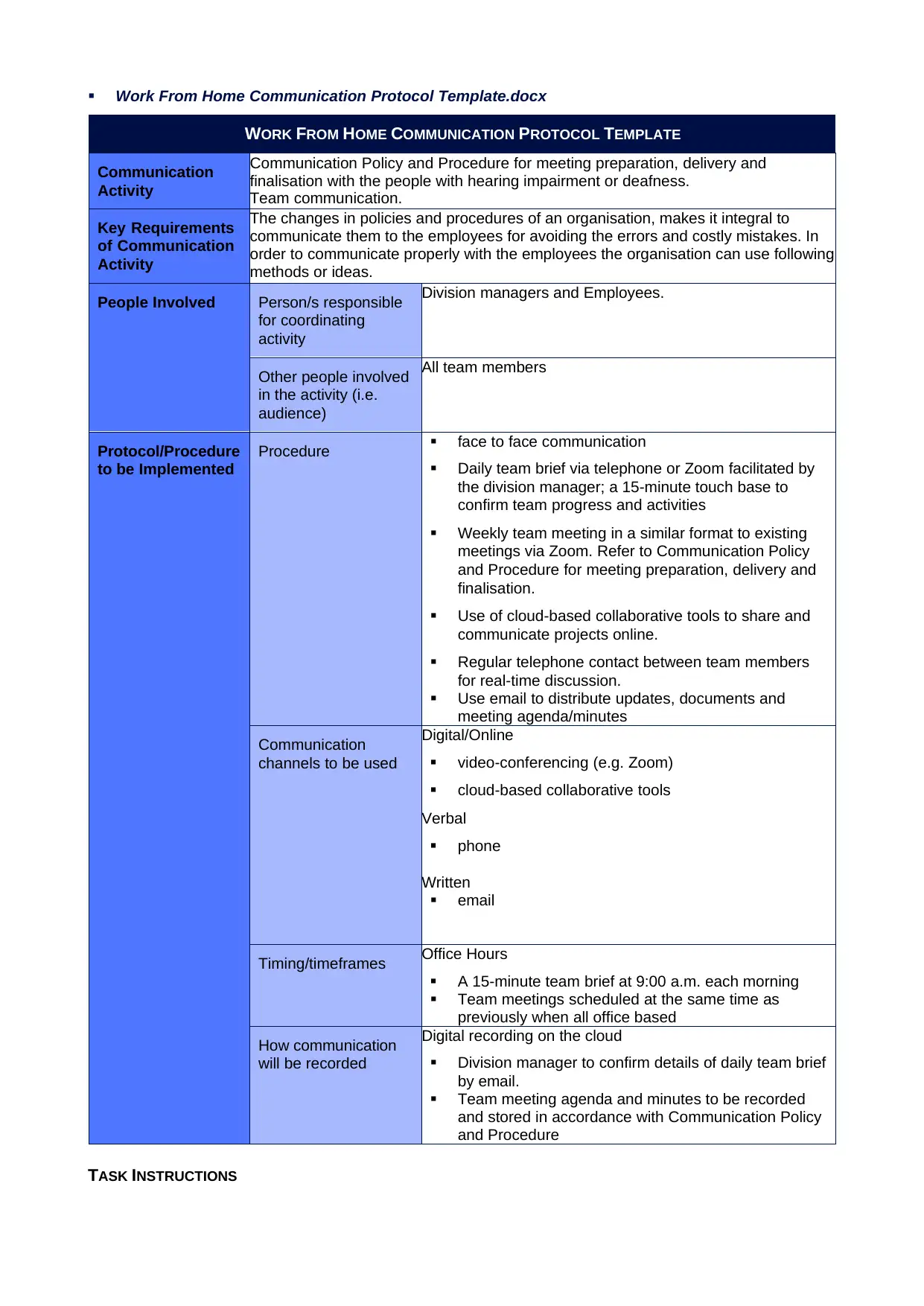
Work From Home Communication Protocol Template.docx
WORK FROM HOME COMMUNICATION PROTOCOL TEMPLATE
Communication
Activity
Communication Policy and Procedure for meeting preparation, delivery and
finalisation with the people with hearing impairment or deafness.
Team communication.
Key Requirements
of Communication
Activity
The changes in policies and procedures of an organisation, makes it integral to
communicate them to the employees for avoiding the errors and costly mistakes. In
order to communicate properly with the employees the organisation can use following
methods or ideas.
People Involved Person/s responsible
for coordinating
activity
Division managers and Employees.
Other people involved
in the activity (i.e.
audience)
All team members
Protocol/Procedure
to be Implemented
Procedure face to face communication
Daily team brief via telephone or Zoom facilitated by
the division manager; a 15-minute touch base to
confirm team progress and activities
Weekly team meeting in a similar format to existing
meetings via Zoom. Refer to Communication Policy
and Procedure for meeting preparation, delivery and
finalisation.
Use of cloud-based collaborative tools to share and
communicate projects online.
Regular telephone contact between team members
for real-time discussion.
Use email to distribute updates, documents and
meeting agenda/minutes
Communication
channels to be used
Digital/Online
video-conferencing (e.g. Zoom)
cloud-based collaborative tools
Verbal
phone
Written
email
Timing/timeframes Office Hours
A 15-minute team brief at 9:00 a.m. each morning
Team meetings scheduled at the same time as
previously when all office based
How communication
will be recorded
Digital recording on the cloud
Division manager to confirm details of daily team brief
by email.
Team meeting agenda and minutes to be recorded
and stored in accordance with Communication Policy
and Procedure
TASK INSTRUCTIONS
WORK FROM HOME COMMUNICATION PROTOCOL TEMPLATE
Communication
Activity
Communication Policy and Procedure for meeting preparation, delivery and
finalisation with the people with hearing impairment or deafness.
Team communication.
Key Requirements
of Communication
Activity
The changes in policies and procedures of an organisation, makes it integral to
communicate them to the employees for avoiding the errors and costly mistakes. In
order to communicate properly with the employees the organisation can use following
methods or ideas.
People Involved Person/s responsible
for coordinating
activity
Division managers and Employees.
Other people involved
in the activity (i.e.
audience)
All team members
Protocol/Procedure
to be Implemented
Procedure face to face communication
Daily team brief via telephone or Zoom facilitated by
the division manager; a 15-minute touch base to
confirm team progress and activities
Weekly team meeting in a similar format to existing
meetings via Zoom. Refer to Communication Policy
and Procedure for meeting preparation, delivery and
finalisation.
Use of cloud-based collaborative tools to share and
communicate projects online.
Regular telephone contact between team members
for real-time discussion.
Use email to distribute updates, documents and
meeting agenda/minutes
Communication
channels to be used
Digital/Online
video-conferencing (e.g. Zoom)
cloud-based collaborative tools
Verbal
phone
Written
Timing/timeframes Office Hours
A 15-minute team brief at 9:00 a.m. each morning
Team meetings scheduled at the same time as
previously when all office based
How communication
will be recorded
Digital recording on the cloud
Division manager to confirm details of daily team brief
by email.
Team meeting agenda and minutes to be recorded
and stored in accordance with Communication Policy
and Procedure
TASK INSTRUCTIONS
Paraphrase This Document
Need a fresh take? Get an instant paraphrase of this document with our AI Paraphraser
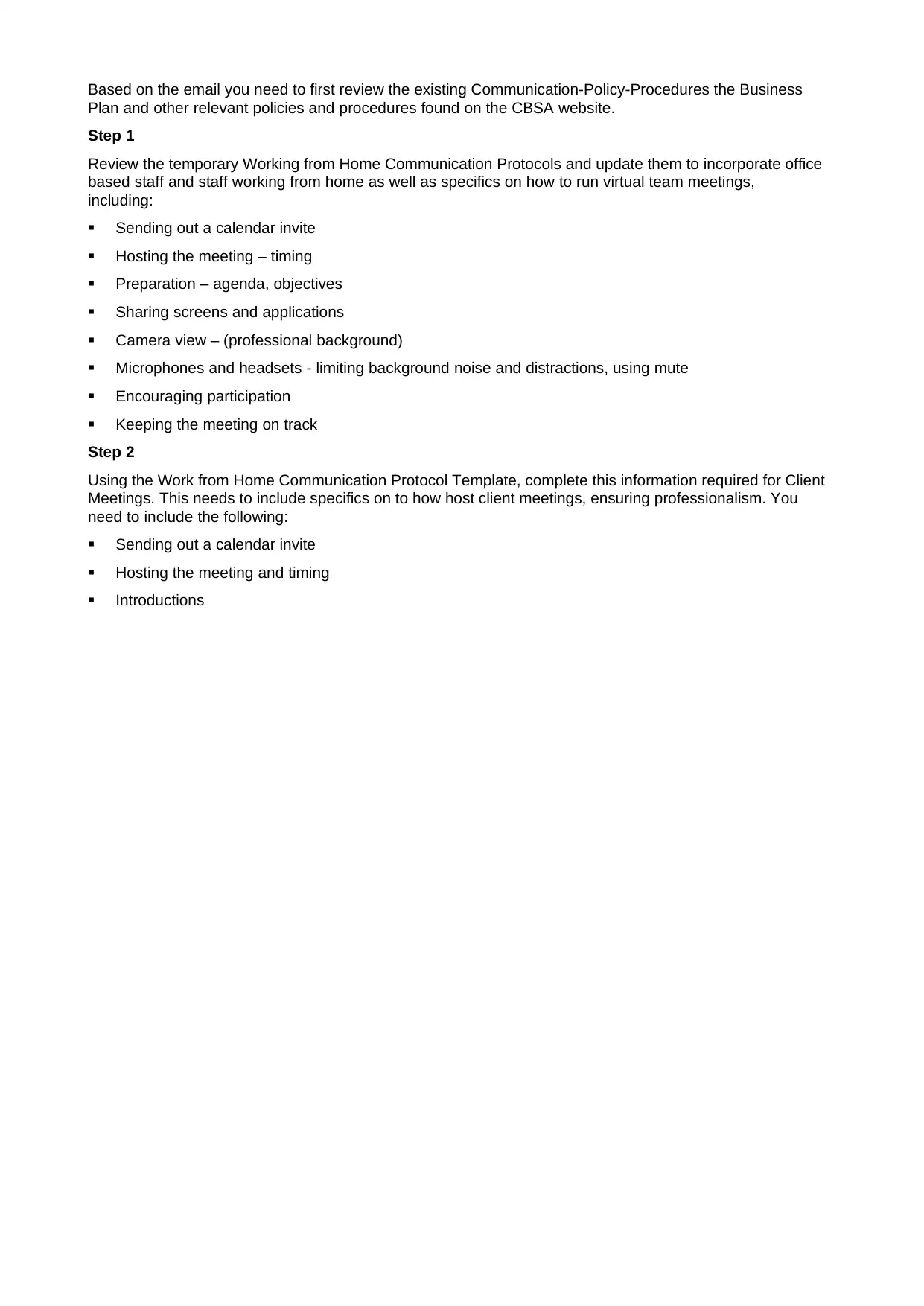
Based on the email you need to first review the existing Communication-Policy-Procedures the Business
Plan and other relevant policies and procedures found on the CBSA website.
Step 1
Review the temporary Working from Home Communication Protocols and update them to incorporate office
based staff and staff working from home as well as specifics on how to run virtual team meetings,
including:
Sending out a calendar invite
Hosting the meeting – timing
Preparation – agenda, objectives
Sharing screens and applications
Camera view – (professional background)
Microphones and headsets - limiting background noise and distractions, using mute
Encouraging participation
Keeping the meeting on track
Step 2
Using the Work from Home Communication Protocol Template, complete this information required for Client
Meetings. This needs to include specifics on to how host client meetings, ensuring professionalism. You
need to include the following:
Sending out a calendar invite
Hosting the meeting and timing
Introductions
Plan and other relevant policies and procedures found on the CBSA website.
Step 1
Review the temporary Working from Home Communication Protocols and update them to incorporate office
based staff and staff working from home as well as specifics on how to run virtual team meetings,
including:
Sending out a calendar invite
Hosting the meeting – timing
Preparation – agenda, objectives
Sharing screens and applications
Camera view – (professional background)
Microphones and headsets - limiting background noise and distractions, using mute
Encouraging participation
Keeping the meeting on track
Step 2
Using the Work from Home Communication Protocol Template, complete this information required for Client
Meetings. This needs to include specifics on to how host client meetings, ensuring professionalism. You
need to include the following:
Sending out a calendar invite
Hosting the meeting and timing
Introductions
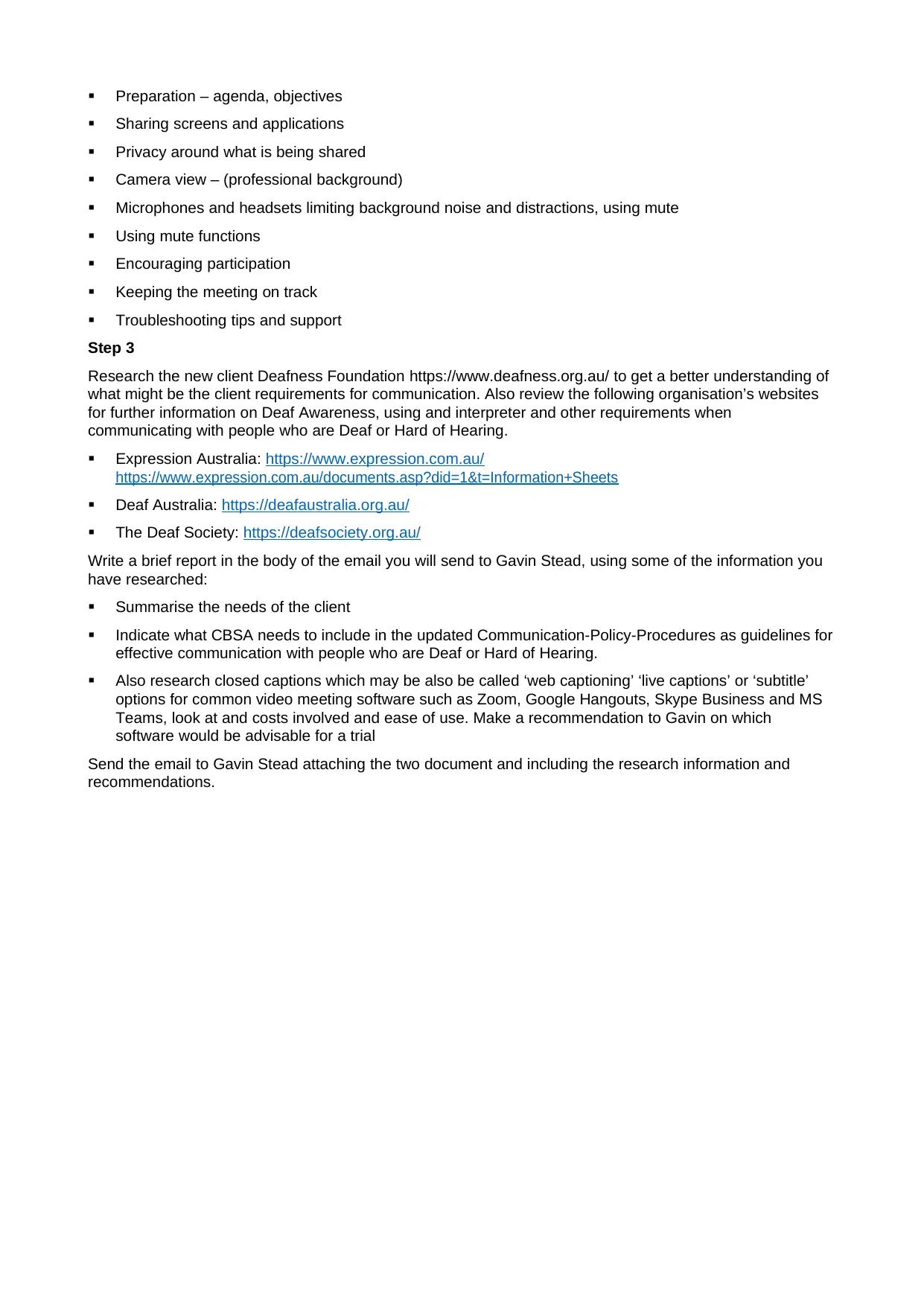
Preparation – agenda, objectives
Sharing screens and applications
Privacy around what is being shared
Camera view – (professional background)
Microphones and headsets limiting background noise and distractions, using mute
Using mute functions
Encouraging participation
Keeping the meeting on track
Troubleshooting tips and support
Step 3
Research the new client Deafness Foundation https://www.deafness.org.au/ to get a better understanding of
what might be the client requirements for communication. Also review the following organisation’s websites
for further information on Deaf Awareness, using and interpreter and other requirements when
communicating with people who are Deaf or Hard of Hearing.
Expression Australia: https://www.expression.com.au/
https://www.expression.com.au/documents.asp?did=1&t=Information+Sheets
Deaf Australia: https://deafaustralia.org.au/
The Deaf Society: https://deafsociety.org.au/
Write a brief report in the body of the email you will send to Gavin Stead, using some of the information you
have researched:
Summarise the needs of the client
Indicate what CBSA needs to include in the updated Communication-Policy-Procedures as guidelines for
effective communication with people who are Deaf or Hard of Hearing.
Also research closed captions which may be also be called ‘web captioning’ ‘live captions’ or ‘subtitle’
options for common video meeting software such as Zoom, Google Hangouts, Skype Business and MS
Teams, look at and costs involved and ease of use. Make a recommendation to Gavin on which
software would be advisable for a trial
Send the email to Gavin Stead attaching the two document and including the research information and
recommendations.
Sharing screens and applications
Privacy around what is being shared
Camera view – (professional background)
Microphones and headsets limiting background noise and distractions, using mute
Using mute functions
Encouraging participation
Keeping the meeting on track
Troubleshooting tips and support
Step 3
Research the new client Deafness Foundation https://www.deafness.org.au/ to get a better understanding of
what might be the client requirements for communication. Also review the following organisation’s websites
for further information on Deaf Awareness, using and interpreter and other requirements when
communicating with people who are Deaf or Hard of Hearing.
Expression Australia: https://www.expression.com.au/
https://www.expression.com.au/documents.asp?did=1&t=Information+Sheets
Deaf Australia: https://deafaustralia.org.au/
The Deaf Society: https://deafsociety.org.au/
Write a brief report in the body of the email you will send to Gavin Stead, using some of the information you
have researched:
Summarise the needs of the client
Indicate what CBSA needs to include in the updated Communication-Policy-Procedures as guidelines for
effective communication with people who are Deaf or Hard of Hearing.
Also research closed captions which may be also be called ‘web captioning’ ‘live captions’ or ‘subtitle’
options for common video meeting software such as Zoom, Google Hangouts, Skype Business and MS
Teams, look at and costs involved and ease of use. Make a recommendation to Gavin on which
software would be advisable for a trial
Send the email to Gavin Stead attaching the two document and including the research information and
recommendations.
⊘ This is a preview!⊘
Do you want full access?
Subscribe today to unlock all pages.

Trusted by 1+ million students worldwide
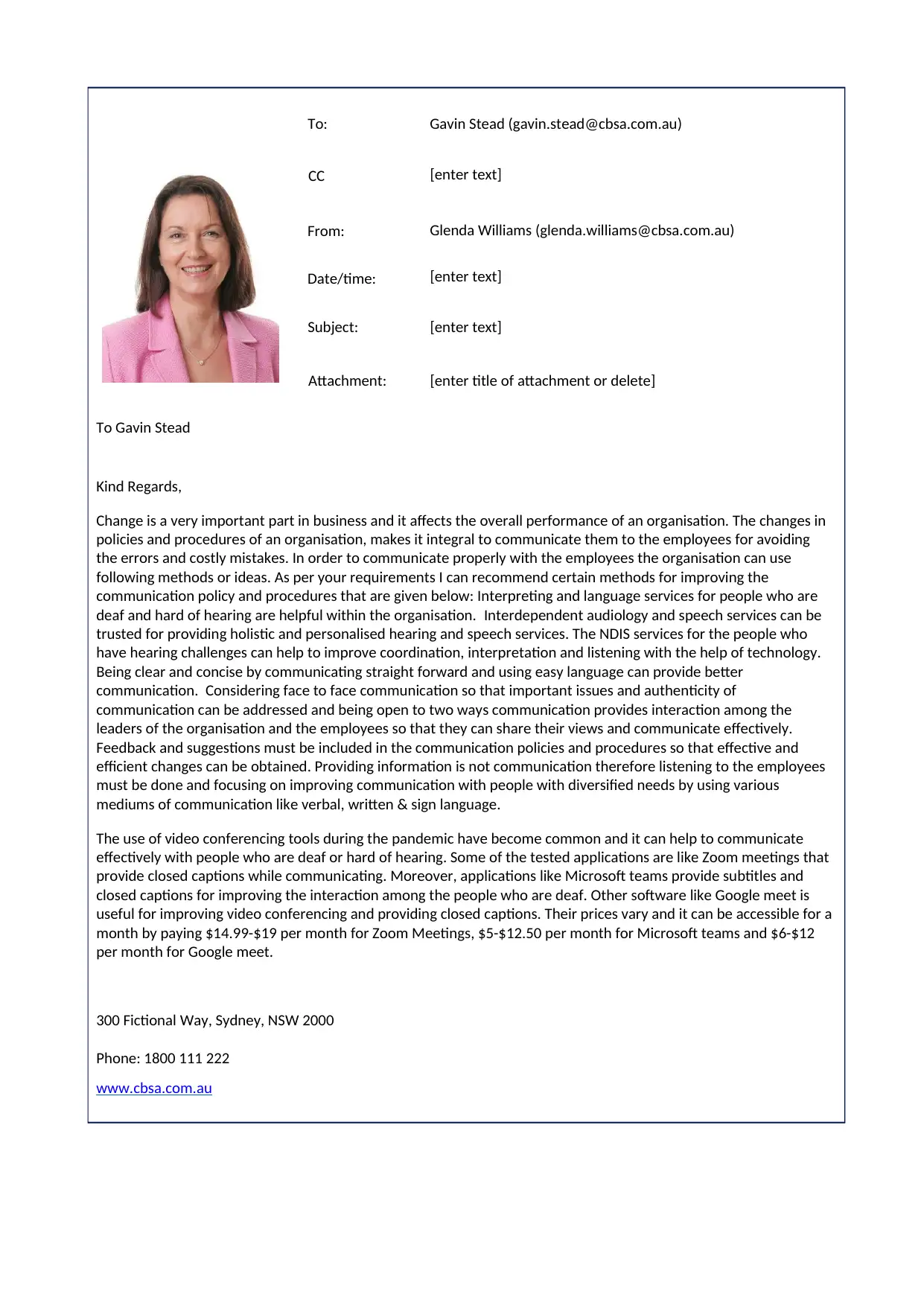
To: Gavin Stead (gavin.stead@cbsa.com.au)
CC [enter text]
From: Glenda Williams (glenda.williams@cbsa.com.au)
Date/time: [enter text]
Subject: [enter text]
Attachment: [enter title of attachment or delete]
To Gavin Stead
Kind Regards,
Change is a very important part in business and it affects the overall performance of an organisation. The changes in
policies and procedures of an organisation, makes it integral to communicate them to the employees for avoiding
the errors and costly mistakes. In order to communicate properly with the employees the organisation can use
following methods or ideas. As per your requirements I can recommend certain methods for improving the
communication policy and procedures that are given below: Interpreting and language services for people who are
deaf and hard of hearing are helpful within the organisation. Interdependent audiology and speech services can be
trusted for providing holistic and personalised hearing and speech services. The NDIS services for the people who
have hearing challenges can help to improve coordination, interpretation and listening with the help of technology.
Being clear and concise by communicating straight forward and using easy language can provide better
communication. Considering face to face communication so that important issues and authenticity of
communication can be addressed and being open to two ways communication provides interaction among the
leaders of the organisation and the employees so that they can share their views and communicate effectively.
Feedback and suggestions must be included in the communication policies and procedures so that effective and
efficient changes can be obtained. Providing information is not communication therefore listening to the employees
must be done and focusing on improving communication with people with diversified needs by using various
mediums of communication like verbal, written & sign language.
The use of video conferencing tools during the pandemic have become common and it can help to communicate
effectively with people who are deaf or hard of hearing. Some of the tested applications are like Zoom meetings that
provide closed captions while communicating. Moreover, applications like Microsoft teams provide subtitles and
closed captions for improving the interaction among the people who are deaf. Other software like Google meet is
useful for improving video conferencing and providing closed captions. Their prices vary and it can be accessible for a
month by paying $14.99-$19 per month for Zoom Meetings, $5-$12.50 per month for Microsoft teams and $6-$12
per month for Google meet.
300 Fictional Way, Sydney, NSW 2000
Phone: 1800 111 222
www.cbsa.com.au
CC [enter text]
From: Glenda Williams (glenda.williams@cbsa.com.au)
Date/time: [enter text]
Subject: [enter text]
Attachment: [enter title of attachment or delete]
To Gavin Stead
Kind Regards,
Change is a very important part in business and it affects the overall performance of an organisation. The changes in
policies and procedures of an organisation, makes it integral to communicate them to the employees for avoiding
the errors and costly mistakes. In order to communicate properly with the employees the organisation can use
following methods or ideas. As per your requirements I can recommend certain methods for improving the
communication policy and procedures that are given below: Interpreting and language services for people who are
deaf and hard of hearing are helpful within the organisation. Interdependent audiology and speech services can be
trusted for providing holistic and personalised hearing and speech services. The NDIS services for the people who
have hearing challenges can help to improve coordination, interpretation and listening with the help of technology.
Being clear and concise by communicating straight forward and using easy language can provide better
communication. Considering face to face communication so that important issues and authenticity of
communication can be addressed and being open to two ways communication provides interaction among the
leaders of the organisation and the employees so that they can share their views and communicate effectively.
Feedback and suggestions must be included in the communication policies and procedures so that effective and
efficient changes can be obtained. Providing information is not communication therefore listening to the employees
must be done and focusing on improving communication with people with diversified needs by using various
mediums of communication like verbal, written & sign language.
The use of video conferencing tools during the pandemic have become common and it can help to communicate
effectively with people who are deaf or hard of hearing. Some of the tested applications are like Zoom meetings that
provide closed captions while communicating. Moreover, applications like Microsoft teams provide subtitles and
closed captions for improving the interaction among the people who are deaf. Other software like Google meet is
useful for improving video conferencing and providing closed captions. Their prices vary and it can be accessible for a
month by paying $14.99-$19 per month for Zoom Meetings, $5-$12.50 per month for Microsoft teams and $6-$12
per month for Google meet.
300 Fictional Way, Sydney, NSW 2000
Phone: 1800 111 222
www.cbsa.com.au
Paraphrase This Document
Need a fresh take? Get an instant paraphrase of this document with our AI Paraphraser
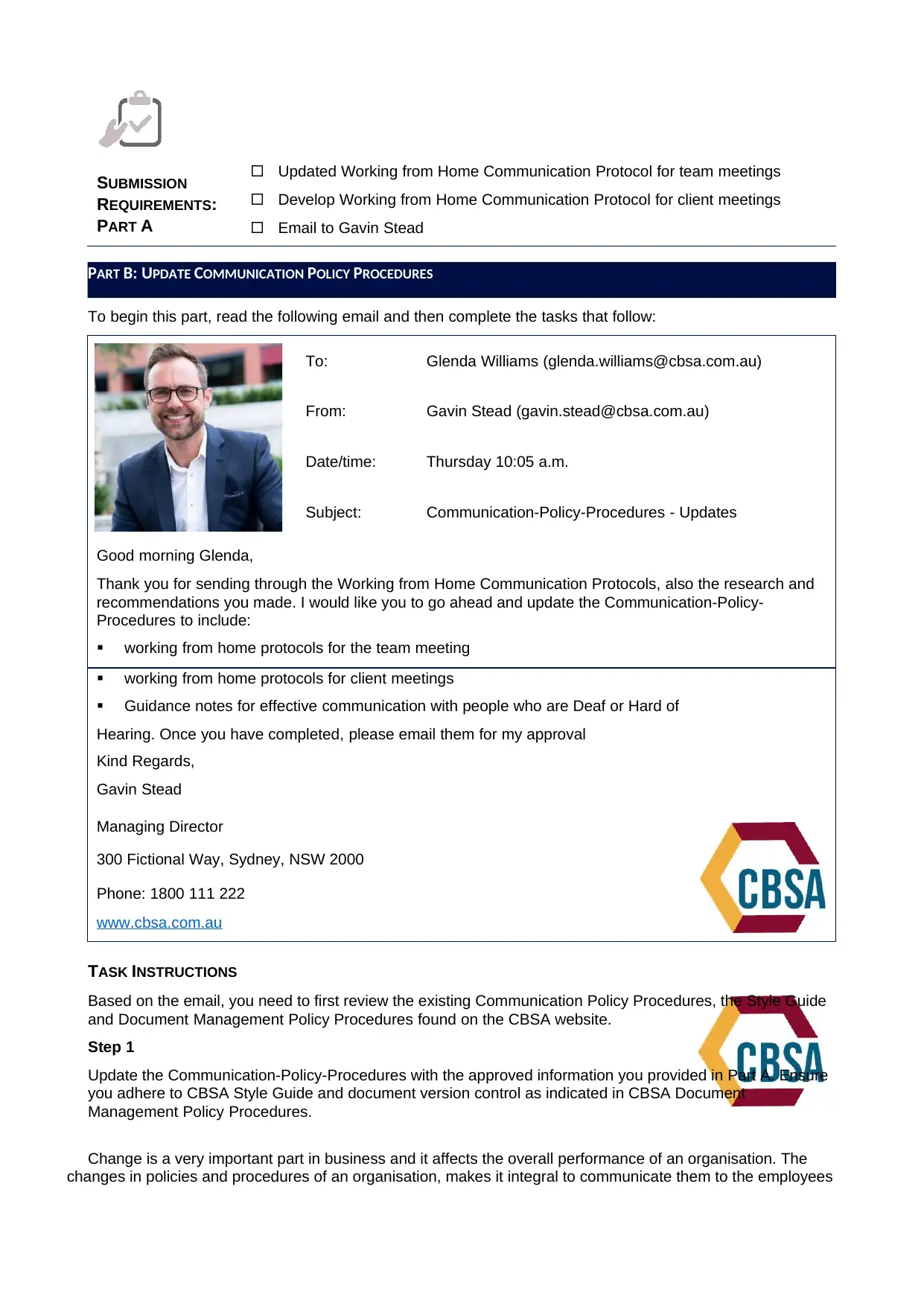
SUBMISSION
REQUIREMENTS:
PART A
Updated Working from Home Communication Protocol for team meetings
Develop Working from Home Communication Protocol for client meetings
Email to Gavin Stead
To begin this part, read the following email and then complete the tasks that follow:
To: Glenda Williams (glenda.williams@cbsa.com.au)
From: Gavin Stead (gavin.stead@cbsa.com.au)
Date/time: Thursday 10:05 a.m.
Subject: Communication-Policy-Procedures - Updates
Good morning Glenda,
Thank you for sending through the Working from Home Communication Protocols, also the research and
recommendations you made. I would like you to go ahead and update the Communication-Policy-
Procedures to include:
working from home protocols for the team meeting
working from home protocols for client meetings
Guidance notes for effective communication with people who are Deaf or Hard of
Hearing. Once you have completed, please email them for my approval
Kind Regards,
Gavin Stead
Managing Director
300 Fictional Way, Sydney, NSW 2000
Phone: 1800 111 222
www.cbsa.com.au
TASK INSTRUCTIONS
Based on the email, you need to first review the existing Communication Policy Procedures, the Style Guide
and Document Management Policy Procedures found on the CBSA website.
Step 1
Update the Communication-Policy-Procedures with the approved information you provided in Part A. Ensure
you adhere to CBSA Style Guide and document version control as indicated in CBSA Document
Management Policy Procedures.
Change is a very important part in business and it affects the overall performance of an organisation. The
changes in policies and procedures of an organisation, makes it integral to communicate them to the employees
PART B: UPDATE COMMUNICATION POLICY PROCEDURES
REQUIREMENTS:
PART A
Updated Working from Home Communication Protocol for team meetings
Develop Working from Home Communication Protocol for client meetings
Email to Gavin Stead
To begin this part, read the following email and then complete the tasks that follow:
To: Glenda Williams (glenda.williams@cbsa.com.au)
From: Gavin Stead (gavin.stead@cbsa.com.au)
Date/time: Thursday 10:05 a.m.
Subject: Communication-Policy-Procedures - Updates
Good morning Glenda,
Thank you for sending through the Working from Home Communication Protocols, also the research and
recommendations you made. I would like you to go ahead and update the Communication-Policy-
Procedures to include:
working from home protocols for the team meeting
working from home protocols for client meetings
Guidance notes for effective communication with people who are Deaf or Hard of
Hearing. Once you have completed, please email them for my approval
Kind Regards,
Gavin Stead
Managing Director
300 Fictional Way, Sydney, NSW 2000
Phone: 1800 111 222
www.cbsa.com.au
TASK INSTRUCTIONS
Based on the email, you need to first review the existing Communication Policy Procedures, the Style Guide
and Document Management Policy Procedures found on the CBSA website.
Step 1
Update the Communication-Policy-Procedures with the approved information you provided in Part A. Ensure
you adhere to CBSA Style Guide and document version control as indicated in CBSA Document
Management Policy Procedures.
Change is a very important part in business and it affects the overall performance of an organisation. The
changes in policies and procedures of an organisation, makes it integral to communicate them to the employees
PART B: UPDATE COMMUNICATION POLICY PROCEDURES
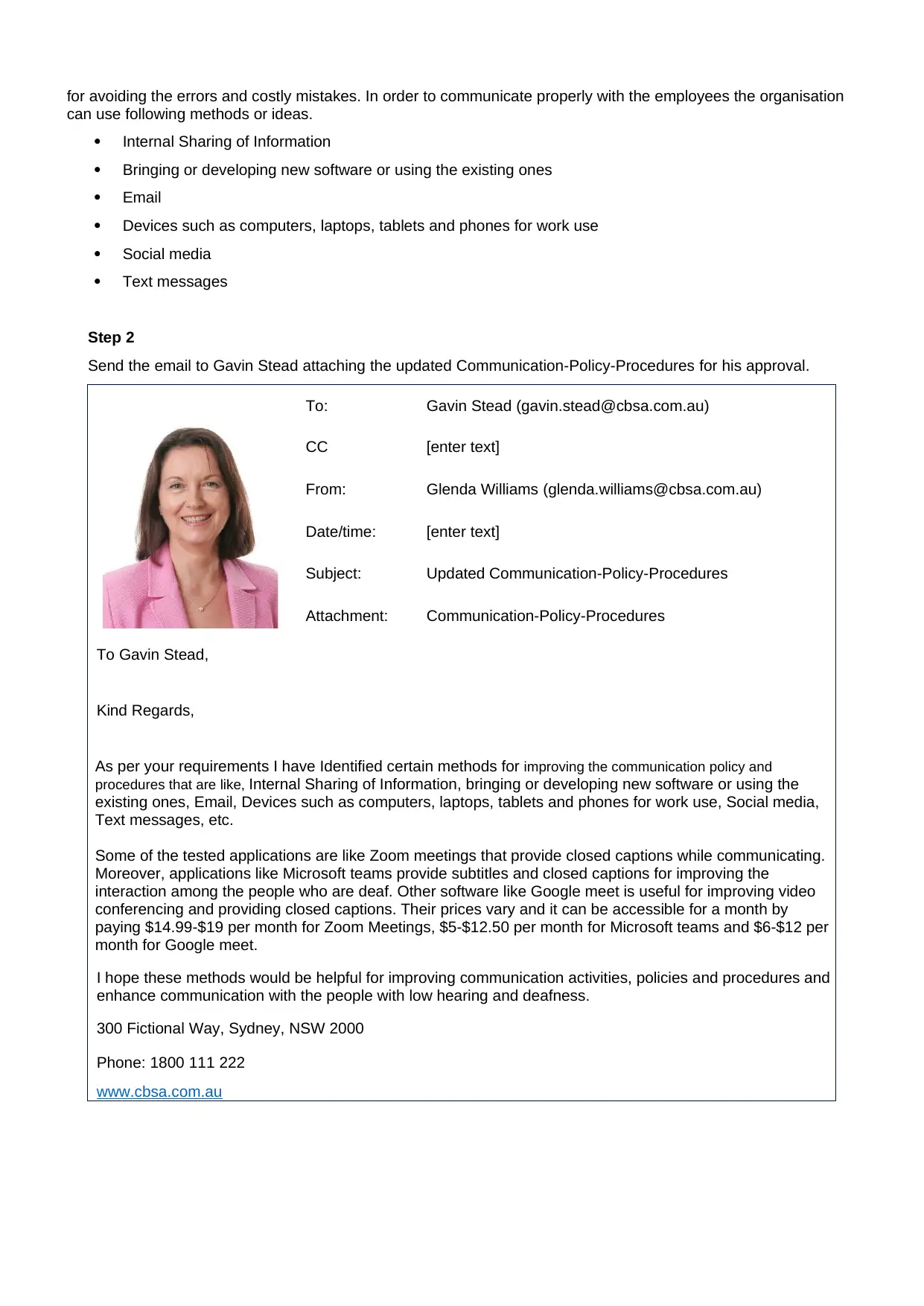
for avoiding the errors and costly mistakes. In order to communicate properly with the employees the organisation
can use following methods or ideas.
Internal Sharing of Information
Bringing or developing new software or using the existing ones
Email
Devices such as computers, laptops, tablets and phones for work use
Social media
Text messages
Step 2
Send the email to Gavin Stead attaching the updated Communication-Policy-Procedures for his approval.
To: Gavin Stead (gavin.stead@cbsa.com.au)
CC [enter text]
From: Glenda Williams (glenda.williams@cbsa.com.au)
Date/time: [enter text]
Subject: Updated Communication-Policy-Procedures
Attachment: Communication-Policy-Procedures
To Gavin Stead,
Kind Regards,
As per your requirements I have Identified certain methods for improving the communication policy and
procedures that are like, Internal Sharing of Information, bringing or developing new software or using the
existing ones, Email, Devices such as computers, laptops, tablets and phones for work use, Social media,
Text messages, etc.
Some of the tested applications are like Zoom meetings that provide closed captions while communicating.
Moreover, applications like Microsoft teams provide subtitles and closed captions for improving the
interaction among the people who are deaf. Other software like Google meet is useful for improving video
conferencing and providing closed captions. Their prices vary and it can be accessible for a month by
paying $14.99-$19 per month for Zoom Meetings, $5-$12.50 per month for Microsoft teams and $6-$12 per
month for Google meet.
I hope these methods would be helpful for improving communication activities, policies and procedures and
enhance communication with the people with low hearing and deafness.
300 Fictional Way, Sydney, NSW 2000
Phone: 1800 111 222
www.cbsa.com.au
can use following methods or ideas.
Internal Sharing of Information
Bringing or developing new software or using the existing ones
Devices such as computers, laptops, tablets and phones for work use
Social media
Text messages
Step 2
Send the email to Gavin Stead attaching the updated Communication-Policy-Procedures for his approval.
To: Gavin Stead (gavin.stead@cbsa.com.au)
CC [enter text]
From: Glenda Williams (glenda.williams@cbsa.com.au)
Date/time: [enter text]
Subject: Updated Communication-Policy-Procedures
Attachment: Communication-Policy-Procedures
To Gavin Stead,
Kind Regards,
As per your requirements I have Identified certain methods for improving the communication policy and
procedures that are like, Internal Sharing of Information, bringing or developing new software or using the
existing ones, Email, Devices such as computers, laptops, tablets and phones for work use, Social media,
Text messages, etc.
Some of the tested applications are like Zoom meetings that provide closed captions while communicating.
Moreover, applications like Microsoft teams provide subtitles and closed captions for improving the
interaction among the people who are deaf. Other software like Google meet is useful for improving video
conferencing and providing closed captions. Their prices vary and it can be accessible for a month by
paying $14.99-$19 per month for Zoom Meetings, $5-$12.50 per month for Microsoft teams and $6-$12 per
month for Google meet.
I hope these methods would be helpful for improving communication activities, policies and procedures and
enhance communication with the people with low hearing and deafness.
300 Fictional Way, Sydney, NSW 2000
Phone: 1800 111 222
www.cbsa.com.au
⊘ This is a preview!⊘
Do you want full access?
Subscribe today to unlock all pages.

Trusted by 1+ million students worldwide
1 out of 59
Related Documents
Your All-in-One AI-Powered Toolkit for Academic Success.
+13062052269
info@desklib.com
Available 24*7 on WhatsApp / Email
![[object Object]](/_next/static/media/star-bottom.7253800d.svg)
Unlock your academic potential
Copyright © 2020–2025 A2Z Services. All Rights Reserved. Developed and managed by ZUCOL.





